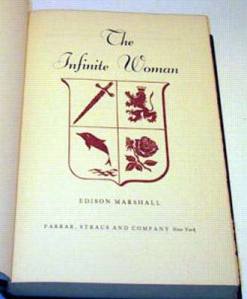
The Infinite Woman, by Edison Marshall, is a book I first read as a teen. It was one of my mother’s books, and at the time – and because she kept it hidden – I thought it some great mystery for me to discover.
I was not wrong.
When I was eleven years young I was introduced to Yoga by way of a book: The Complete Illustrated Book of Yoga, by Swami Vishnudevananda. I still have the 1965 hardback copy with cover. So it was then, at an early age, I became taken with Yoga. Then, a scant two years later, discovering The Infinite Woman, my soul was awakened yet again.
How?
In my first introduction to Yoga, I was immediately and intimately attracted to Siva. I quickly and whole-heartedly knew the teachings I found there, as laid out by Swami Sivananda Saraswati and the Divine Life Society. Two years later I met Kali Ma, also in the pages of a book. Where Siva had been my father, she became my mother.
And I met her through The Infinite Woman. The author, Edison Marshall, was quite the man’s man during the 1950s: a second lieutenant in the U.S. Army, a novelist, adventurer, and tiger hunter. He wrote over 23 novels and short stories, and all of them can best be described as a mix between manly action/adventure and romance.
The book’s heroine is Lola Montaro, who casts a striking image on every page. She is a true rogue .. glamorous and exotic, sensuous and mysterious, innocent yet complicated. And she was my first non-Yoga introduction to Kali:
I walked hand in hand with Manu, until the moonlight showed us
the form and face of Kali under a stone cowl.
She was pit-black with four arms, each with a red-palmed hand;
her eyes were red, and her tongue and face
and breasts were stained with blood; her teeth were pointed fangs,
and around her neck was a string of skulls
and about her waist a girdle of twisted snakes.
-page 19
But before you think our heroine is simply the dream of a fanciful and lust filled author, think again, for she is based on the quite real and equally intriguing, Lola Montez.

The book is filled with chapters that conjured vast and mystifying images in my thirteen year young mind: India, The Novice, The Worldly, Krishna the Joyous, and The Dark Mother. As the titles suggest, our heroine never forsakes Kali; from the moment she first embraced her as a child, discovering her dark terror at a cremation ground, until she watches her lover embrace death as he falls through darkness – laughing.
This book spurred me to find books on Kali at the local library, but such specialized books were too much to ask for. There were plenty of books on Yoga – its history, practice, science and the like, to keep me busy – but none to fill in the gaps found in Lola’s adventures. Especially any that would expound on her unswerving devotion to Her.
Not until I asked Her.
When I was 15, having exhausted my search – yet never tiring – I asked Kali to guide me, to “Show me your true form.” And She did, via the Karpuradi Stotra, by Sir John Woodroffe (aka: Arthur Avalon). Here, she is detailed in all the glory and gore that Edison Marshall described. She is portrayed as the “forbidden thing”, as death personified, as the assimilating and transformative force of nature as experienced and lived by the fictional Lola.
From Her Panca Tattva dance upon the ashen grounds of cremation, to her fierce gaze and matted hair, to the fragrant Akanda flowers at her feet, and to the midnight mumblings of mad priests. Her many faces are oceans apart, yet close as drops upon the soul. She is vicious and gentle, slayer and creatrix, Mistress of the Five Elements and Mistress to Hara. She is creator and destroyer, the object of meditation and the non-self, bringer of fear and boon .. even Time stands still before Her.
O Mother! There are those who worship
many other devas than thyself,
thinking they grant greater boons.
But they are devoid of discrimination,
knowing nothing of what is real,
for they are separated from the truth.
So great my Bhakti, my desire for You,
that it controls my approach to You –
the Primordial One, She of the Present Moment –
who was before the beginning of the world.
You who enjoys the Great Bliss of Union –
the Union of Sivasakti, the Kundalini Sahasrara –
and who is worshiped by
Vishnu, Siva, Brahma and all other Devas,
for they worship You – Mother of All.
-verse 13

- I pulled my copy of The Infinite Woman today, and laid it on the desk next to Hymns to the Goddess and Hymn to Kali. I have been reading them all day .. lingering among memories that seem as rough and unhewn as Her temple stones; yet fresh as the violet bloomed Akanda .. and like its gentle wafting Buri’r Chul .. my soul is carried deftly towards Her.
- Prem and Metta!
- Yoginiji
33.838998
-83.900738



